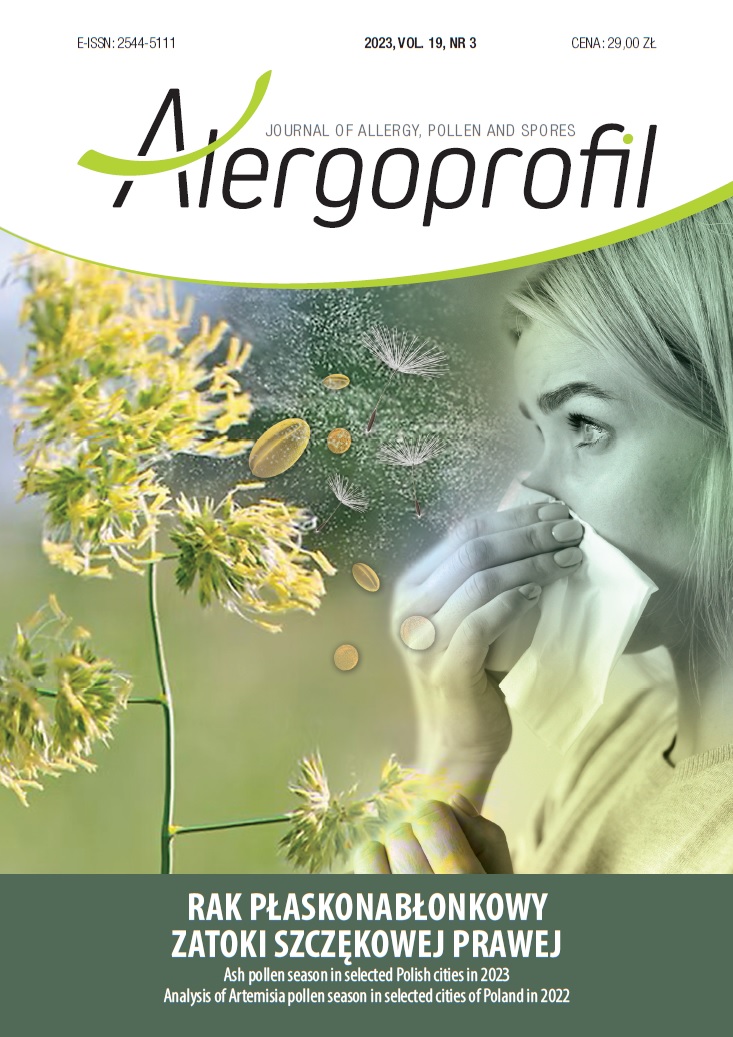Ash pollen season in selected Polish cities in 2023 Artykuł oryginalny
##plugins.themes.bootstrap3.article.main##
Abstrakt
According to some authors, ash pollen has strong allergenic properties. In Europe the allergenic significance of this pollen has been poorly studied as the amounts of ash pollen in the air are low. However, in Poland we are more and more often observing ash pollen seasons with the total annual pollen sum exceeding 1000 grains. In 2023, it was found in Cracow and Łódź. This study compares the ash pollen seasons in Bialystok, Bydgoszcz, Cracow, Kielce, Piotrkow Trybunalski, Opole, Olsztyn, Szczecin, Lodz, Wroclaw, Zielona Gora, Warsaw and Lublin in 2023. The investigations were carried out using the volumetric method (Hirst type pollen sampler). Seasonal pollen index (SPI) was estimated as the sum of daily average pollen concentrations in the given season. The ash pollination is mainly observed in April. Diagnosis of ash pollen allergy is made difficult due to an overlapping pollination period with Betulaceae and some cross-reactivity with allergens from birch, and even privet and olive. It is not clear whether ash pollen is a primary cause of sensitization or whether it is implicated through cross-sensitization to other pollens. In 2023 the pollen season of ash started first in Kielce and Opole, on the March 11th and 13th. At the latest, a pollen season ended in Bialystok, on the May 12th. The differences of pollen seasons duration were very considerable, from 23 to 57 days. The highest airborne concentration of 530 (!) pollen grains/m3 was noted in Cracow on the April 3rd. The peak values of seasonal pollen count in Polish cities occurred between April 3rd and 24th, most often between April 17th and 24th. The highest ash pollen allergen hazard occurred in 2023 in Cracow and Lodz, and was at least 2–3 times higher than in other cities. The highest variability in the analysed seasons was found in the peak value and annual total.
Pobrania
##plugins.themes.bootstrap3.article.details##
Copyright: © Medical Education sp. z o.o. This is an Open Access article distributed under the terms of the Attribution-NonCommercial 4.0 International (CC BY-NC 4.0). License (https://creativecommons.org/licenses/by-nc/4.0/), allowing third parties to copy and redistribute the material in any medium or format and to remix, transform, and build upon the material, provided the original work is properly cited and states its license.
Address reprint requests to: Medical Education, Marcin Kuźma (marcin.kuzma@mededu.pl)
Bibliografia
2. Vara A, Fernández-Gonzáleza M, Airab MJ et al. Fraxinus pollen and allergen concentrations in Ourense (South-western Europe). Environ Res. 2016; 147: 241-8.
3. Silva Palacios I, Tormo Molina R, Munoz Rodriguez AF. The importance of interactions between meteorological conditions when interpreting their effect on the dispersal for pollen from homogeneously distributed sources. Aerobiologia. 2007; 23: 17-26.
4. Shah M. Facts, Prevention, and Relief for Ash Tree Allergies for 2023. Online (access: 28.07.2023).
5. Ralska-Jasiewiczowa M, Latałowa M, Wasylikowa K et al. (ed). Late Glacial and Holocene history of vegetation in Poland based on isopollen maps. Polish Academy of Sciences, Cracow 2004.
6. Jianan X, Zhiyun O, Hua Z et al. Allergenic pollen plants and their in‑uential factors in urban areas. Acta Ecologica Sinica. 2007; 27(9): 3820-7.
7. Szmidt M, Gondorowicz K. Bronchial asthma caused by exposure to ash wood dust. Pol Tyg Lek. 1994: 49(14-15): 343-4.
8. Mandrioli P, Comtois P, Dominguez E et al. Sampling: Principles and Techniques. In: Mandrioli P, Comtois P, Levizzani V (ed). Methods in Aerobiology. Pitagora Editrice Bologna, Bologna 1998: 47-112.
9. Emberlin J, Savage M, Woodman R. Annual variations in the concentrations of Betula pollen in the London area 1961–1990. Grana 1993; 32: 359-63. http://doi.org/10.1080/00173139309428965.
10. Lipiec A, Weryszko-Chmielewska E, Piotrowska K et al. Analiza stężenia pyłku jesionu w wybranych miastach Polski w 2007 r. Alergoprofil. 2007; 3(3): 50-4.
11. Rapiejko P. Alergeny pyłku jesionu. Alergoprofil. 2008; 4(1): 46-8.
12. Steinman H. Tree pollens. Allergy – Which allergens? Allergy Resources International. Sweden 2008: 188.
13. Peeters AG. Frost periods and beginning of the ash (Fraxinus excelsior L.) pollen season in Basel (Switzerland). Aerobiologia. 2000; 16: 353.
14. Martínez-Cañavate Burgos A, Torres-Borrego J, Molina Terán AB et al. Molecular sensitization patterns and influence of molecular diagnosis in immunotherapy prescription in children sensitized to both grass and olive pollen. Pediatr Allergy Immunol. 2018; 29: 369-74.
15. Szczygielski K, Puc M, Stacewicz A et al. Ash pollen count in the air of selected Polish cities in 2017. Alergoprofil. 2017; 13(2): 85-90.
16. Puc M, Kotrych D, Lipiec A et al. Ash pollen season in Poland in 2019. Alergoprofil. 2019; 15(4): 17-22. http://doi.org/10.24292/01.AP.154201119.
17. Puc M, Rapiejko P, Myszkowska D et al. Pyłek jesionu w powietrzu wybranych miast Polski w roku 2008. Alergoprofil. 2008; 4(3): 35-9.
18. Ogren T. The Allergy-Fighting Garden. Ten Speed Press, Berkeley, CA 2015: 205.

